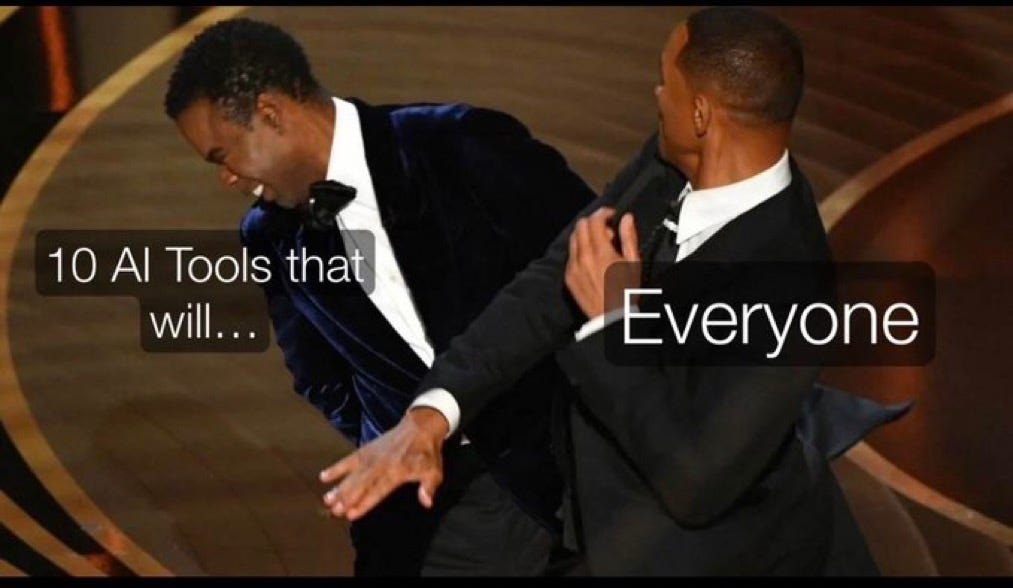Controlled Hallucinations (007)
Your weekly review of our transition toward AGI and computational creativity.
We are nearly halfway into June and back from a brief unplanned break from our weekly newsletter cadence. This edition attempts to reflect on how we should design our AI and what these designs should optimize for through our usual assortment of links to lectures, presentations and articles. Last week I had the delightful privilege of hanging out with a couple of readers in the flesh and briefly talk about what is resonating from these weekly expeditions while in Sintra. I am left with the impression that AI is irreparably embedded into all industries and areas of interest & that whatever happens next needs be considered with regards to AI and not despite of it. This moment invites us to explore more kinds of reality and all types of intelligence. If the limits of our language are the limits of our world, then maybe we should consider more kinds of languages to broaden our horizons.
MZ
AI capabilities and risks ⚠️
Few organizations seem as concerned about the implications of emerging technology as CHT – the Center of Humane Technology. Their approach to outlining potential benefits of AI while cautioning about the misaligned incentives that could lead to harmful outcome is crucial. In this recent presentation, co-founder Randy Fernando speaks about existential risks associated with AI and underscores the importance of changing economic incentives and mental operating systems in order to address them. Highly recommended.
Anatomy of an AI Copilot 🧑🏽✈️
Microsoft CTO and EVP of AI, Kevin Scott presents different approaches for developing GPT-modeled copilot interfaces. How to design, orchestrate and stage interactions between users and AI appears to have become one of the most important aspects in how we bring generative AI to more people, safely.
Research on passing the Turing test 🏳️
Interesting quantified experiment to evaluate how well different people are at identifying AI, and why. 68% of people guessed correctly when asked to determine whether they talked to a fellow human or AI bot. Women and 18-44 year olds are slightly better, while French people are significantly better than the average.
Long Read
OpenAI's plans according to Sam Altman 🗺️
Surprisingly detailed overview of OpenAI’s technical roadmap and bottlenecks via Raza Habib. The interview was quickly deleted from the original website, so catch it before it’s gone from Archive.org.
Twitter thread about how ChatGPT actually works 🪶
Which is itself a summary of Stephen Wolfram’s seminal article.
On designing simulations 🏘️
Will Wright the creator of SimCity and other simulation games, discusses the design and development of simulators and gameplay and the challenges of creating educational games. Recording from 1996 but has only gained relevance since.
Emerging Vocabulary
Vectorization
The process of converting raw data into a format that can be understood and processed by the AI algorithm. One common use of vectorization is in the processing of text data, where each word or phrase is represented as a vector in a multi-dimensional space. This is done because machine learning algorithms (like neural networks) work with numerical data, not raw text. This vectorization of text data allows the algorithm to identify and quantify patterns in the text, and is key to tasks like sentiment analysis, text classification, or machine translation.
Update: there is now a dedicated page for all previous emerging vocabulary entries on newsletter.envisioning.io.
Project Showcase
Albus
Use ChatGPT to learn pretty much anything. Albus is a knowledge explorer allowing you to generate new ideas and learn about new areas of knowledge in seconds. Start with a topic you want to explore and it gives you an expanding array of related topics.
Via @heyBarsee on Twitter.
Prompt Techniques

Technology & Culture
AI for human connection
By Luma Eldin: Last month, the US Surgeon General, Dr. Vivek Murthy, warned of an imminent epidemic of loneliness, isolation, and disconnection. Technology platforms meant for social connection ironically contribute to this crisis by reducing face-to-face interactions, promoting superficial relationships, and fostering social comparison. Now, AI companions such as Xiaoice in China and Replika in the US are addressing this issue by offering social support and emotional engagement through empathetic conversations. In response to the dramatic changes in Japanese social dynamics caused by an exponentially demanding work culture and hence the increasing number of single individuals, Gatebox's Azuma Hikers serves as a projected "digital wife" for Japanese adults. Some argue that voice recognition, gesture control, and artificial intelligence are creating immersive and interactive experiences that could be as, or even more, fulfilling than ‘physical reality’ relationships. The nuances of cultural practices and relationship norms will continue to influence how different communities develop and interact with AI companions, for better or worse. As the world grapples with increasing loneliness, it prompts us to question whether AI can fulfill our innate need for connection, while also considering how our cultural preferences will be reflected and translated in the virtual world.
Inspired by TECH DREAMS OF AI @ HOBB Productivity all the way, or is there a chance for intimacy? With Katy Mogal and Markos Grohmann.
If Artificial Insights makes sense to you, please help us out by:
Subscribing to the weekly newsletter on Substack.
Forwarding this issue to colleagues and friends wanting to learn about AGI.
Sharing the newsletter on your socials.
Commenting with your favorite talks and thinkers.
Artificial Insights is written by Michell Zappa, CEO and founder of Envisioning, a technology research institute.
You are receiving this newsletter because you signed up on envisioning.io.





